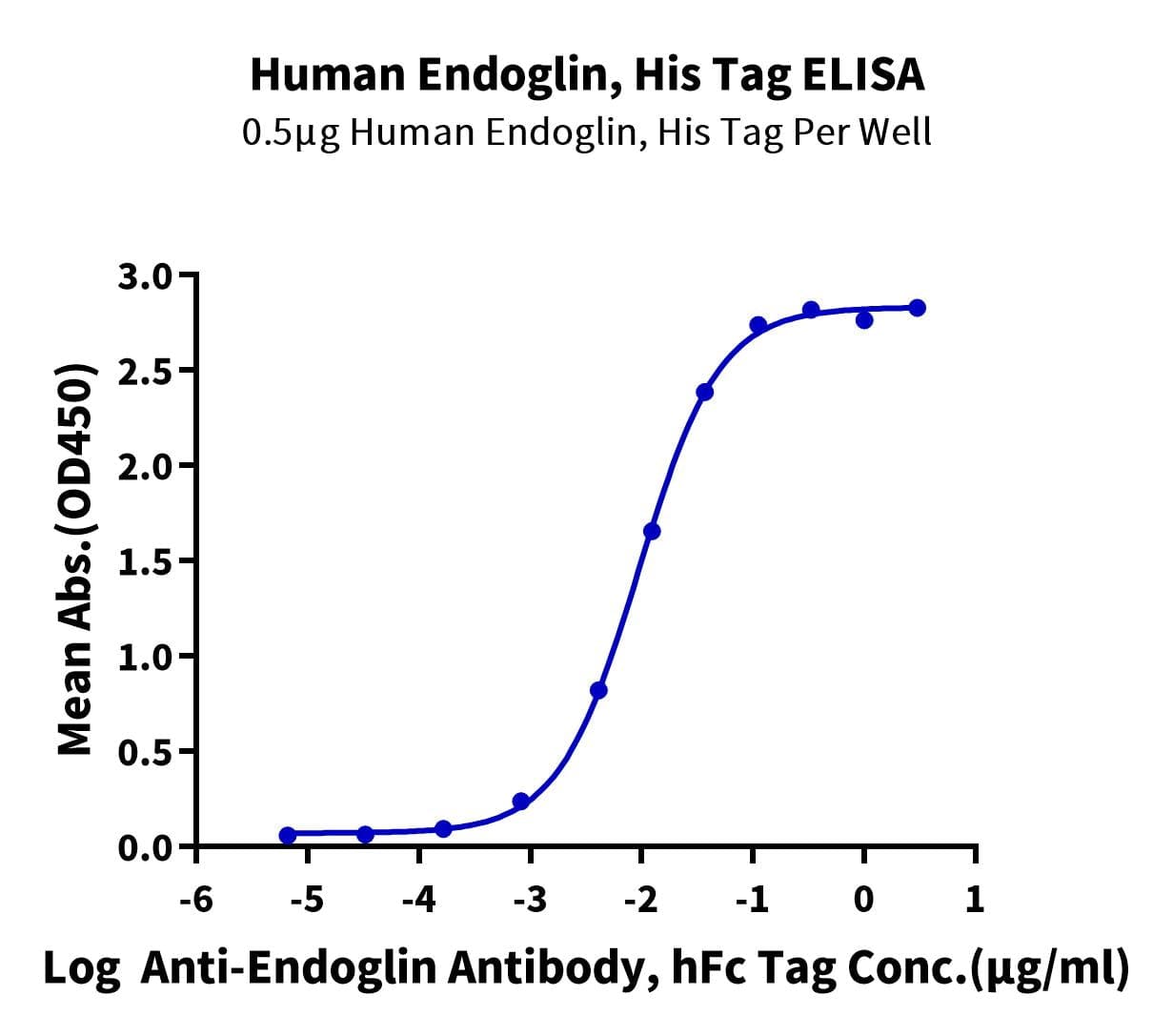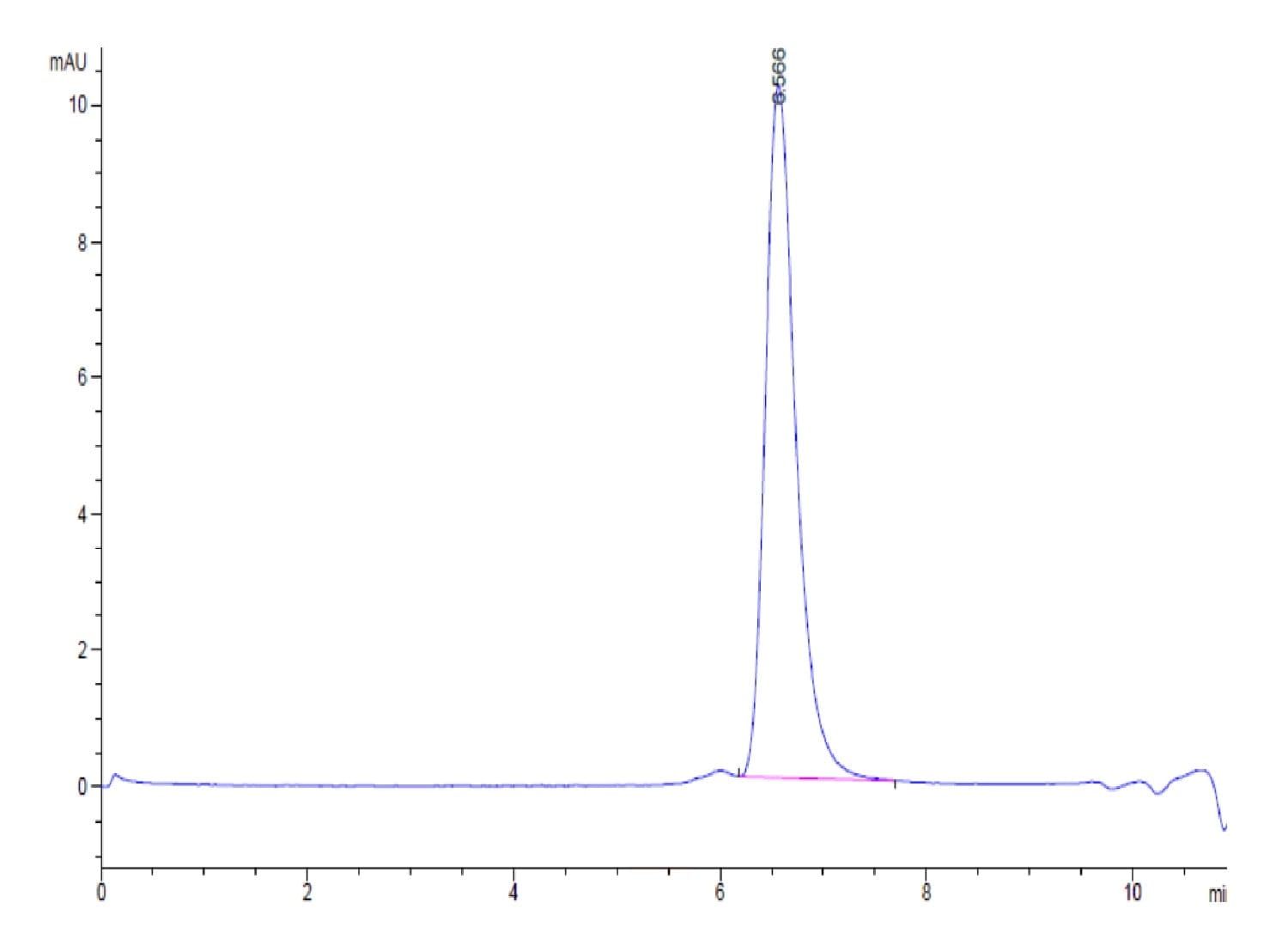| Weight | 1 lbs |
|---|---|
| Dimensions | 9 × 5 × 2 in |
| accession | P17813 |
| express system | HEK293 |
| product tag | C-His-Avi |
| purity | > 95% as determined by Tris-Bis PAGE;> 95% as determined by HPLC |
| background | Endoglin (CD105) is a 90 kDa type I transmembrane glycoprotein of the zona pellucida (ZP) family of proteins. Endoglin is a vascular endothelium glycoprotein that plays an important role in the regulation of angiogenesis. Required for normal structure and integrity of adult vasculature (PubMed:7894484). Regulates the migration of vascular endothelial cells. Required for normal extraembryonic angiogenesis and for embryonic heart development. May regulate endothelial cell shape changes in response to blood flow, which drive vascular remodeling and establishment of normal vascular morphology during angiogenesis. |
| molecular weight | The protein has a predicted MW of 63.7 kDa. Due to glycosylation, the protein migrates to 70-82 kDa based on Tris-Bis PAGE result. |
| available size | 100 µg, 500 µg |
| endotoxin | Less than 1EU per μg by the LAL method. |
Human Endoglin/CD105 Protein 4657
$270.00 – $900.00
Summary
- Expression: HEK293
- Functional: Yes (ELISA)
- Amino Acid Range: Glu26-Gly586
Human Endoglin/CD105 Protein 4657
| protein |
|---|
| Size and concentration 100, 500µg and lyophilized |
| Form Lyophilized |
| Storage Instructions Valid for 12 months from date of receipt when stored at -80°C. Recommend to aliquot the protein into smaller quantities for optimal storage. Please minimize freeze-thaw cycles. |
| Storage buffer Shipped at ambient temperature. |
| Purity > 95% as determined by Tris-Bis PAGE |
| target relevance |
|---|
| Endoglin (CD105) is a 90 kDa type I transmembrane glycoprotein of the zona pellucida (ZP) family of proteins. Endoglin is a vascular endothelium glycoprotein that plays an important role in the regulation of angiogenesis. Required for normal structure and integrity of adult vasculature (PubMed:7894484). Regulates the migration of vascular endothelial cells. Required for normal extraembryonic angiogenesis and for embryonic heart development. May regulate endothelial cell shape changes in response to blood flow, which drive vascular remodeling and establishment of normal vascular morphology during angiogenesis. |
| Protein names Endoglin (CD antigen CD105) |
| Gene names ENG,ENG END |
| Mass 9606Da |
| Function Vascular endothelium glycoprotein that plays an important role in the regulation of angiogenesis (PubMed:21737454, PubMed:23300529). Required for normal structure and integrity of adult vasculature (PubMed:7894484). Regulates the migration of vascular endothelial cells (PubMed:17540773). Required for normal extraembryonic angiogenesis and for embryonic heart development (By similarity). May regulate endothelial cell shape changes in response to blood flow, which drive vascular remodeling and establishment of normal vascular morphology during angiogenesis (By similarity). May play a critical role in the binding of endothelial cells to integrins and/or other RGD receptors (PubMed:1692830). Acts as a TGF-beta coreceptor and is involved in the TGF-beta/BMP signaling cascade that ultimately leads to the activation of SMAD transcription factors (PubMed:21737454, PubMed:22347366, PubMed:23300529, PubMed:8370410). Required for GDF2/BMP9 signaling through SMAD1 in endothelial cells and modulates TGFB1 signaling through SMAD3 (PubMed:21737454, PubMed:22347366, PubMed:23300529). |
| Catalytic activity #N/A |
| Subellular location Cell membrane ; Single-pass type I membrane protein . |
| Tissues Detected on umbilical veil endothelial cells (PubMed:10625079). Detected in placenta (at protein level) (PubMed:1692830). Detected on endothelial cells (PubMed:1692830). |
| Structure Homodimer; disulfide-linked (PubMed:1326540, PubMed:21737454, PubMed:22347366, PubMed:28564608, PubMed:8370410). Forms a heteromeric complex with the signaling receptors for transforming growth factor-beta: TGFBR1 and/or TGFBR2 (PubMed:1326540). It is able to bind TGFB1 and TGFB2 with high affinity, but not TGFB3 (PubMed:1326540, PubMed:8370410). Interacts with GDF2, forming a heterotetramer with a 2:2 stoichiometry (PubMed:21737454, PubMed:22347366, PubMed:28564608). Interacts with ACVRL1 (PubMed:22347366, PubMed:28564608). Can form a heteromeric complex with GDF2 and ACVRL1 (PubMed:28564608). Interacts with BMP10 (PubMed:21737454). Interacts with DYNLT4 (PubMed:16982625). Interacts with ARRB2 (PubMed:17540773). |
| Domain Th |
| Target Relevance information above includes information from UniProt accession: P17813 |
| The UniProt Consortium |
Data
Publications
Publications
| pmid | title | authors | citation |
|---|---|---|---|
| We haven't added any publications to our database yet. | |||
Protocols
| relevant to this product |
|---|
Documents
| # | ||
|---|---|---|
| Please enter your product and batch number here to retrieve product datasheet, SDS, and QC information. | ||

















